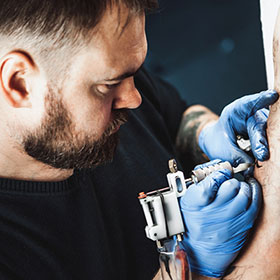Yes, flight attendants can have tattoos. But there are rules.
Airlines have different policies about visible tattoos. Working as a flight attendant comes with unique challenges. One common question is about tattoos. Many people wonder if visible tattoos are allowed. Tattoos are a form of personal expression. However, they can also clash with professional standards.
Airlines aim to keep a clean and professional appearance. As a result, each airline has its own rules about tattoos. Some airlines allow them if they are not visible. Others have strict no-tattoo policies. Understanding these rules is essential for aspiring flight attendants. In this blog post, we will explore the various tattoo policies across airlines. This will help you know what to expect if you have tattoos and dream of flying high.
Introduction To Airline Tattoo Policies
Airline rules about tattoos started strict. Most airlines did not allow visible tattoos. This was to keep a neat and professional look. Airlines thought tattoos did not fit this image.
Some airlines now allow visible tattoos. But they must follow certain rules. Tattoos should not be offensive. They should also be small. Each airline has its own rules. Always check before getting a tattoo.
Major Airlines’ Tattoo Regulations
American Airlines has strict rules about tattoos. Visible tattoos are not allowed. Tattoos must be covered by the uniform. If a tattoo cannot be hidden, it must be removed. This rule applies to all flight attendants.
Delta Airlines also has clear rules about tattoos. Tattoos must not be visible while in uniform. Any visible tattoo must be covered. If it cannot be covered, it must be removed. This policy ensures a professional look.
Regional Airlines’ Stances
U.S. regional airlines have strict rules. Tattoos must be covered. Visible tattoos are not allowed. This means arms, neck, and face. Some airlines may allow small tattoos. But they must be hidden by the uniform. Flight attendants should use makeup or bandages. This is to cover tattoos if needed.
European airlines are a bit more flexible. Some allow small visible tattoos. Others follow strict rules like U.S. carriers. Tattoos must be professional. They should not be offensive. Placement matters. Tattoos on arms or legs might be okay. But neck and face tattoos are usually not allowed. Policies can vary by airline.
International Airlines’ Policies
Many Asian airlines have strict tattoo policies for flight attendants. Tattoos must be covered at all times. Some airlines do not allow tattoos at all. They believe visible tattoos can be unprofessional. Flight attendants might need to wear long sleeves or use special makeup. Each airline has its own rules. It is important to check specific policies before applying.
Middle Eastern airlines often have very strict rules on tattoos. Tattoos must not be visible while in uniform. Some airlines may not hire individuals with tattoos. This is due to cultural values and company image. Flight attendants must follow dress codes and appearance standards. Always check the airline’s guidelines before considering a job.
Visible Vs. Non-visible Tattoos
Flight attendants with tattoos must follow strict rules. Tattoos must be covered. The airline might ask them to use makeup. Long sleeves can also hide tattoos. It is important to check with the airline first. Some airlines are stricter than others.
Tattoos in non-visible places are usually okay. For example, tattoos on the back or upper legs. Tattoos under the uniform are often fine. Always ask the airline about their rules. Each airline has different policies.
Tattoo Size And Content Restrictions
Tattoos must be small. They should not be larger than a coin. Airlines often allow tattoos that can be covered. Hands, face, and neck tattoos are usually not allowed.
Inappropriate or offensive designs are banned. This includes symbols of hate. Profane words are also not permitted. Many airlines check for these designs. They want to maintain a professional image.
Employee Perspectives On Tattoo Policies
Some flight attendants have tattoos. They share mixed feelings. Many hide tattoos while at work. They follow airline rules. Some airlines are strict. They do not allow visible tattoos. This can be hard for some employees.
Strict tattoo policies can affect hiring. Some good candidates have tattoos. They might not apply. They choose airlines with relaxed rules. This limits the talent pool. Airlines may miss out on skilled workers. Tattoo-friendly policies can attract more applicants. It can bring in a diverse workforce.
Future Trends In Airline Tattoo Policies
Airlines might allow more visible tattoos soon. A few airlines already let staff show small tattoos. This trend may grow. Policies could change to attract younger workers. New rules might permit tattoos if they aren’t offensive.
Society is more accepting of tattoos now. Many people have them. This change in societal norms can affect airline rules. Companies may update policies to reflect this shift. Visible tattoos might become common for flight attendants. Acceptance of body art is rising globally.
Conclusion
Ultimately, flight attendants can have tattoos, but rules vary by airline. Many airlines accept tattoos if they are hidden. Visible tattoos might limit opportunities. Research specific airline policies before applying. Consider tattoo placement carefully. Professional appearance remains crucial in the aviation industry.
Tattoos can be a form of self-expression. Balance personal style with career requirements. With careful planning, tattoos and a flight attendant career can coexist.

